Rococó: its characteristics, main works and artists
Rococo was a European art movement of French origin that was characterized by its cheerful and provocative style, and a taste for excessive decoration. It manifested itself in painting, architecture, decorative arts, and sculpture.
Rococo art developed in the early 18th century, in the transition period between Baroque and Neoclassical art. Although it shares with the baroque the interest in the profusion of details, it is distinguished from it by substituting its solemnity and drama for pleasure and amusement.

Such was the desire for entertainment that, according to researcher Michael Levey, the rococo respected neither the Church nor the State. Love, sensuality, and everyday life were more interesting subjects than spiritual or temporal glories.
The word rococo comes from the term rocaille, a kind of garden decoration based on the use of seashells or pebbles, very popular in Italy and France during the seventeenth century. Both the use of these motifs and the similarity in the effects achieved led to the application of the term Rococo to this style.
To understand this style, let us know below its characteristics, its main representatives and works and its historical context.
Rococo art characteristics

Unlike Baroque art, Rococo art was characterized by being cheerful, celebrating life, giving space to humor, grace and light eroticism. It can be said that it was, in reality, the expression of a social class that fled from boredom through an enthusiastic art, without transcendent or didactic pretensions.
Funny and festive character
Rococo art was, above all, a style that sought to express grace and joy. His character was festive. Although the rococo was ornamented in the decoration, its atmospheres sought to be bright and enthusiastic.
Humor and mischief
Rococo art is the expression of an elite that has fun. Therefore, it has a large dose of humor and mischief that suppresses any attempt at solemnity. For this reason, the rococo also expresses the relaxation of the label.
Topics without moralizing or didactic pretense

The favorite subjects in the rococo were sentimental adventures, pastoral scenes, the entertainment of the idle elite and domestic life. But despite the sweetened appearance of the songs, they had a connection to experience.
Religious, mythological or historical themes were not stopped, but they were stripped of their solemnity. Gone are the scenes that were moralizing, didactic or displaying power. Every subject passed through the filter of grace, pleasure and everyday life.
Veiled eroticism
Art was nourished by a veiled eroticism, both in its forms and in its themes. In some artists, mythology was a hiding place to justify the development of the erotic nude, in such a way that it did not suffer criticism from intellectual elites.
Sumptuous and imaginative decor
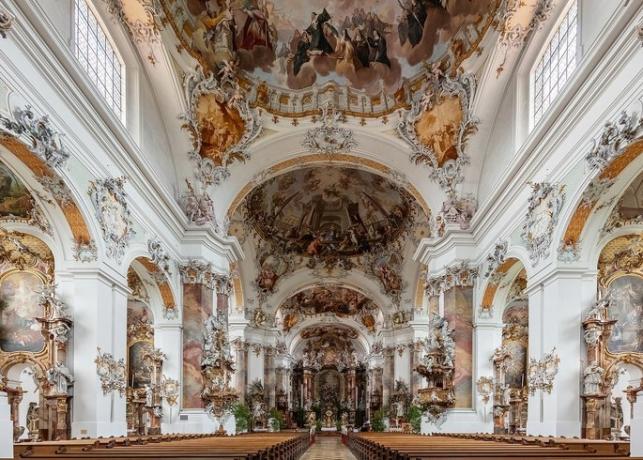
Rococo was an art attentive to detail and excessive ornamentation. The artists, designers and architects enriched the decoration of the works with elements as profuse as they were imaginative. It was not strange to find elements of eastern cultures such as fauna, flora and all kinds of motifs.
Use of pastel and white tones
One of the ways that Rococo artists found to bring grace and joy was to change the palette from earthy, dark and rich colors to pastels and whites. This was applied both in painting and in architectural decoration, thanks to which everything was wrapped in grace and sensuality.
Art freed from its propaganda function
The rococo freed art from its propagandist role. Art was no longer at the service of ecclesiastical or absolutist causes, and this influenced thematic and style freedom. Art no longer had to be the vehicle of a "truth", nor did it need to be serious. It was enough that he was placid.
Rococo painting
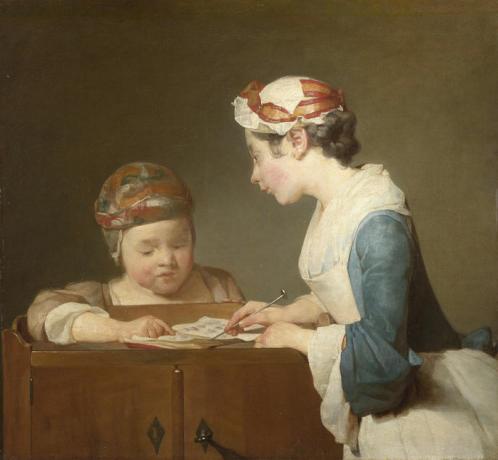
Rococo painting represented a triumph of Rubenism over Poussinism. By Rubenismo is known the current of colorful painters inspired by the Flemish Baroque painter Pedro Pablo Rubens (1577-1640), who made color prevail over drawing. Poussinism is known as the current that favored drawing over color, influenced by the French painter Nicolás Poussin (1594-1665). The colorism was characteristic of the Rococo painters.
His placid and graceful character contrasted with the drama of the Baroque. In France, court life began to revolve around entertainment and banalities, such as love affairs, games, or everyday life, all of which were reflected in the painting. That joyous spirit quickly permeated the European courts, but each country adapted it to its particularities.
Rococo painters
Antoine Watteau (1684-1721). Watteau was a painter from a Flemish city that had been annexed to France. He was the first artist to address the concerns of the idle elite. But he was also the one who gave the characters "humanity." Among his most important works are Pilgrimage to the island of Kythera (1717), The scale of love (1717); Venetian party (1719).
Jean-Baptiste-Simeon Chardin (1699-1779). He was a freelance French painter, thanks to the financial resources of his wife. He was particularly concerned with representing domestic life. Among his most important works are The boy with the spinning top (1737), The young governess (1740) and The blessing.
François Boucher (1703-1770). French painter who worked under the protection of King Louis XV's favorite, the Marquise de Pompadour. He treated many mythological, pastoral and idyllic subjects with great exuberance. Among his most important works are Portrait of Madame de Pompadour (1759); Young man reclining (1752) and Diana after bath (1742).
Jean-Honoré Fragonard (1732-1806). He was a French painter who made hedonism, eroticism, exuberance and the intimate atmosphere the most representative signs of his painting. Among his most important works are The swing (1767), Blind man (1769), The lock (1779), The stolen kiss (1788).
Giovanni Battista Tiepolo (1696-1770). Italian painter widely recognized in Europe. She developed the religious theme. She also performed mythological and everyday themes. Some of his best known works are: Transfer of the Holy House of Loreto (1743-1745), Frescoes from the Würzburg Residence (1752-1753), Young man with a parrot (1760) and Frescoes in the Royal Palace of Madrid (1762-1766).
William Hogarth (1697-1764). English painter who put into practice the resources and pastel colors of the Rococo, but ridiculed social conventions, especially those of the elite. Among his best known works are: The four moments of the day (1736), The career of a prostitute (1732) and Marriage a-la-mode (h. 1743).
Thomas Gainsborough (1727-1788). English painter. He was characterized by portraying people in credible attitudes, provided with grace. He focused on the small local aristocracy. He was noted for his interest in landscape, which he always uses in the background of his paintings. Among his works are: Mr. and Mrs. Andrews (1749), The young blue (1770) and Dr. Ralph Schomberg.
Rococo architecture
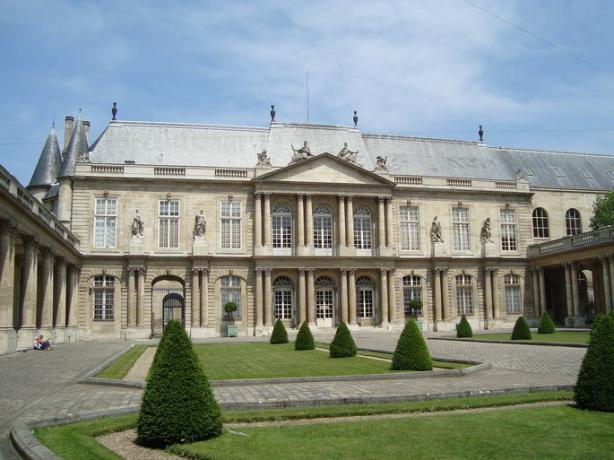
Rococo architecture was characterized by being austere in the exterior finishes, but very rich and profuse in the interior decoration. The interior spaces were smaller and treated with greater intimacy, thanks to the use of delicate and gentle forms.
The interior decoration was noted for its ingenuity and imagination. The golden appliques were the order of the day, serving the most varied curved shapes with floral motifs, seashells and all kinds of sinuosities. The colors were always bright and cheerful.
The French architect Germain Boffrand was responsible for introducing the Rococo in France, and put especially at the service of the monarchical order, although he eventually developed projects religious. He participated in projects such as the Place Vendôme in Paris, the Conservatory of Versailles, the Hotel de Soubise in Paris and the Castle of Lunéville.

Rococo aesthetics were highly valued in Austria and the German states that were part of the Holy Roman Empire, both in religious architecture and civil architecture.
Examples of this are the Basilica of Vierzehnheiligen by Johann Balthasar Neumann, and the Ottobeuren Abbey in Bavaria. In Prussia, he highlighted the construction of the Sanssouci Palace, in Postdam, under the direction of Georg Wenzeslaus von Knobelsdorff.
In Spain, the pre-eminence of the Baroque and the lack of artistic exchanges with France and Germany especially, made it difficult to spread the Rococo style. However, there were also some valuable expressions facilitated by the presence of the churrigueresque.
For example, the decoration of the sacristy of La Cartuja de Granada, probably started by Hurtado Izquierdo and continued by José de Bada. It is also worth mentioning the Transparent of the Cathedral of Toledo, by Narciso Tomé. Finally, the façade of the Palacio del Marqués de Dos Aguas, designed by Hipólito Rovira.
Rococo furniture

In this period, a style called Louis XV was created, in attention to the dominant aesthetic taste at court. This style became an international fashion. The cabinetmaking would be characterized by the use of varnishing and bronze marquetry. The most used motifs were floral, although rock inlays, masks and scenes were also applied.
Likewise, furniture began to be designed for the relaxed stay of the nobles in the court, something that until then was not usual. This brought about the development of the art of upholstery for furniture.
Rococo sculpture

Both the free-standing sculpture and the service of architecture played a role in the rococo. One of its most notable differences was the diminution of the colossal dimensions of the Baroque. Rococo also tried to accentuate softness and delicacy in the treatment of textures and movements.
Although sculptors maintained interest in marble, porcelain was used assiduously. Plaster and wood sculptures were also made. As for the color, when they applied it, they kept the pastel tones to lighten the atmosphere.
Among the most prominent Rococo sculptors we find Antonio Corradini and Étienne-Maurice Falconet.
Antonio Corradini (1688-1752). He was an Italian painter who worked in the service of the court of Charles VI. He was known for the way he treated clothing, especially the see-through effect. Some of the most commented works of him are: The Veiled Woman (Faith) Y Modesty, also called Veiled Truth.
Étienne-Maurice Falconet (France, 1716 - 1791). He was one of the protégés of the Marquise de Pompadour. Some art researchers study him as a figure of the transition to neoclassicism. Among his works are: Menacing cupid (1757) and Pygmalion and Galatea (1763).
Historical context of the rococo
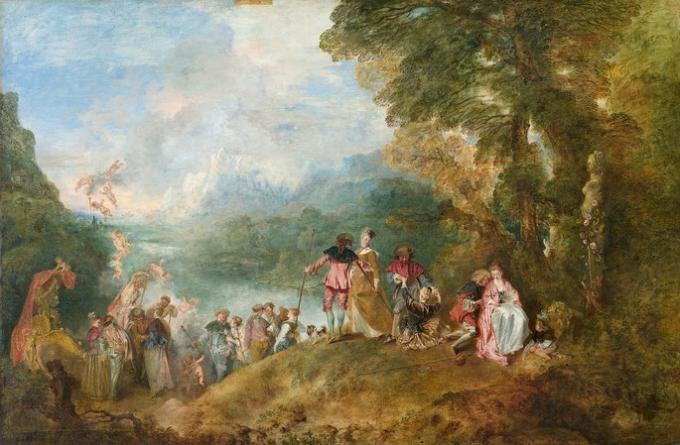
The Baroque had dominated Western aesthetics since the mid-16th century and throughout the 17th century. Those were times of wars of religion and consolidation of absolutisms.
In France, towards the last years of the government of King Louis XIV, the stability achieved made baroque ceremoniality unnecessary. But then, the Sun King felt the nobles as a threat. Near the end of his reign, the king stripped the nobility of their power in the field, making them an idle elite.
Three events were fundamental in the impulse of the rococo:
- the death of King Louis XIV;
- the influence of King Louis XV's favorite, the Marquise de Pompadour;
- the exchange of artists between the different European courts.
The king is dead. Long live the king!
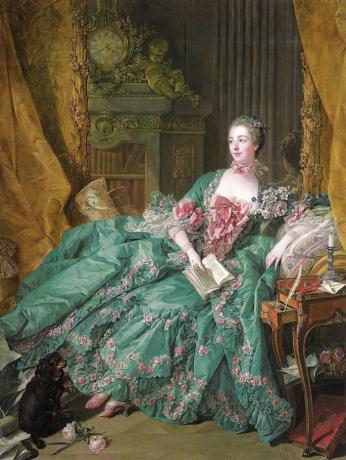
On the death of Louis XIV, the court moved from Versailles to Paris, while the boy Louis XV awaited the age to ascend to the throne. In Paris the nobles came into contact with the most powerful economic elites and with the officials of the Treasury. Little by little the forms of the label relaxed, according to researcher Stephen Richard Jones in his book Introduction to the history of art: the seventeenth century.
Now that the nobles were idle and bored, it was necessary to maintain their interest in the court and provide them with new occupations. Little by little an answer will be found in art. Jones states that:
"Rococo art only tried to delight a well-to-do society, really idle, for which the only sin was to bore."
When the young Louis XV took office, the new prosperity renewed the ideals of patronage in the hands of the private sector. One of the most important patrons of that time was the king's mistress, Jeanne-Antoine Poisson, Marchioness of Pompadour, known for being a protector of the arts.
Thus a market was created that, inspired by Watteau, was interested in domestic life, eroticism, the celebration of life and pleasure. But above all, he was interested in love affairs, the best antidote to boredom.
That moment in history witnessed the mobility of artists between countries like never before. The new art - which left the significance of the baroque behind - made its way in much of Europe.
Decline
In the middle of the 18th century, Enlightenment thinkers such as Voltaire proclaimed the dominance of reason and the measure of passions for the common good. The rococo seemed an unacceptable excess to them. Accused of being superfluous, if not immoral, the rococo was associated with the decline of the Old Regime.
Under the influence of the Enlightenment, the architect Jacques François Blodel joined the voices that disqualified the artistic style of the Old Regime. He then proposed a modernization of art that accompanied the growing republicanism in the political debate.
As if it were a pendulum, over time drawing triumphed over color again and, under the command philosophical and political thought, art returned to academicism, moralization and propagandism of Condition. Thus neoclassical art was born.
You may also like:
- Baroque: characteristics, representatives and works.
- Neoclassicism: Characteristics of Neoclassical Literature and Art.
References:
- Levey, Michael (1998): From the rococo to the Revolution: main trends in painting in the 18th century. Barcelona: Destino Editions.
- Jones, Stephen Richard (1985): Introduction to Art History: The 18th Century. Barcelona: Editorial Gustavo Gili / Círculo de Lectores / University of Cambridge.



